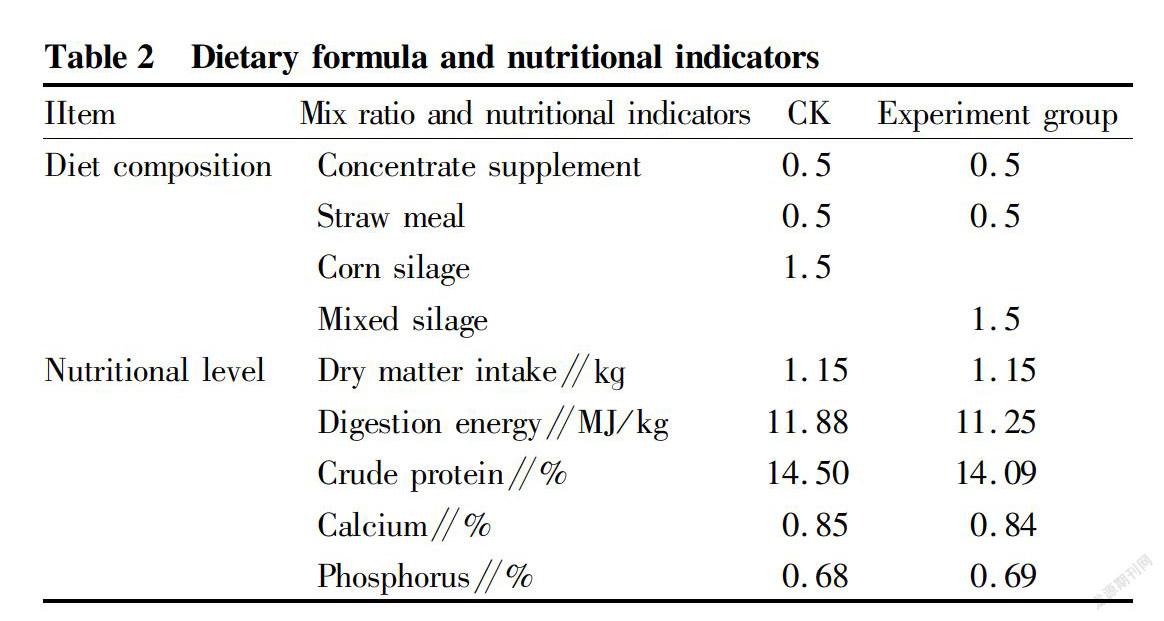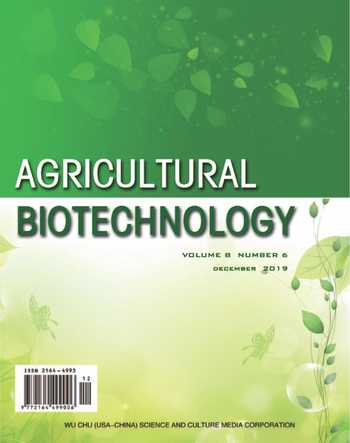Experiment on the Fattening Effects of Mixed Silage of Wolfberry Branches on Hybrid
2019-09-10YourenDINGHuaYUNNinganMEIJianningDINGYupingYANDeyunYANG
Youren DING Hua YUN Ning an MEI Jianning DING Yuping YAN Deyun YANG




Abstract [Objectives] This study was conducted to use the feeding value of wolfberry branches and to provide a basis for the rational use of its active ingredients and nutrients and the development of new feed resources.
[Methods] Wolfberry branches and wholeplant corn were used to make mixed silage of wolfberry branches, which replaced different proportions of wholeplant corn silage for feeding hybrid mutton sheep, and the feeding effect of the mixed silage of wolfberry branches on hybrid mutton sheep was analyzed, which provides a technical basis for rational utilization of mulberry resources to ruminants. A single factor feeding comparison experiment was carried out. 32 hybrid mutton sheep of 8 months old with conform gender, age, body weight, physiological state and feeding management level were selected and divided into two groups, 16 in each group.
[Results] The gross output value of weight gain of the experimental group was 18.06 yuan, which was higher than the CK (12.97 yuan) by 5.09 yuan.
[Conclusions] The addition of the mixed silage of wolfberry branches to the diet had a positive effect on the increase of the weight gain of the hybrid mutton sheep and the reduction of the feed conversion ratio compared with the single wholeplant corn silage.
Key words Wolfberry branches; Mixed silage; Hybrid mutton sheep; Fattening effect
Received: August 19, 2019Accepted: November 4, 2019
Supported by Ningxia Key R & D Program (2019BBF02016); Special Fund for Agricultural Science and Technology Independent Innovation of Ningxia Academy of Agriculture and Forestry Sciences.
Youren DING (1963-), male, P. R. China, assistant researcher, devoted to research about animal nutrition research, development, production and technology promotion.
*Corresponding author. Email: meiningan@163.com.
Wolfberry is a traditional precious medicinal materials in China. Its fruit, leaves and roots are considered to be treasures. Modern research shows that wolfberry fruit and leaves are not only rich in proteins, fat and vitamins, but also rich in almost all essential amino acids, minerals, wolfberry polysaccharides, and active ingredients including lutein, zeaxanthin, cryptoxanthin and taurine. The planting area of Ningxia has increased to nearly 33 350 hm2, and the total production has exceeded 80 000 t. During the cultivation and processing of wolfberry, large amounts of new branches, leaves and slag are produced. After stumping in autumn, a lot of new branches will sprout in April next year. Fresh branches and leaves can be freshly fed, or they can be fed in dry manner or silage. The animals are fond of wolfberry feed, which has higher nutritional value than sweet clover, but wolfberry materials have not been scientifically and effectively utilized so far, leading to waste of resources and environmental pollution. Meanwhile, the development of animal husbandry, especially for herbivore production, another pillar industry of Ningxia is constrained by the lack of forage. The purpose of this study is to utilize the feeding value of wolfberry branches to provide a basis for rational use of its active ingredients and nutrients and to develop new feed resources. In this study, wolfberry branches and wholeplant corn were used to make mixed silage of wolfberry branches, which replaced different proportions of wholeplant corn silage for feeding hybrid mutton sheep, and the feeding effect of the mixed silage of wolfberry branches on hybrid mutton sheep was analyzed, which provides a technical basis for rational utilization of mulberry resources to ruminants.
Experimental Design
Experimental grouping
A single factor feeding comparison experiment was conducted, and 32 hybrid mutton sheep of 8 months old with conform gender, age, body weight, physiological state and feeding management level were selected and divided into two groups, 16 in each group. The sheep were uniformly worn ear tags and reared intensively in different groups.
Experimental location and time
The experiment was carried out from July 12 to August 18, 2019, in the sheep farm of Yanchi Qianhe Forage Distribution Co., Ltd.
Experimental treatments
Silages using different raw material types was used as different treatments, in which the experimental group was fed with mixed silage of wolfberry branches, and the control group (CK) was fed with wholeplant corn silage.
Experimental diet
The diet consisted of concentrate supplement + roughage + silage. The concentrate supplement was composed of corn, bran, sunflower cake, salt and premix. The roughage was straw meal. The formulas and nutritional indicators of the diet are shown in Table 1, Table 2. The silage of the control group was 100% corn silage, and the silage of the experimental group was 50% corn silage + 50% wolfberry branch silage.
Experimental arrangement
The experiment period was 30 d. The deworming and stomach invigorating were carried out before the experiment, and the feed and formula remained unchanged during the feeding period.
Determined items
Body weight: At the beginning and end of the experiment, the initial weight and the final weight were measured to evaluate the effect of liveweight gain.
Feed consumption: The actual consumption of concentrate in each group of sheep during the experiment period was counted.
Feed conversion: The feed conversion ratio was calculated on the basis of the feed consumption and the weight gain of each group of sheep.
Statistical Analysis
The test data were subjected to biological statistical processing and economic benefit calculation, and the statistical results and conclusions were correctly evaluated.
Results and Analysis
Experiment observation
There was no significant change in the experimental group compared with the CK. In the experimental group, the feces, hair color and mental state were good, and there were no clinical symptoms.
Weight gain
The results of sheep weight gain and feed conversion ratio are shown in Table 3.
It can be seen from Table 3 that the average daily weight gain was 132.67 g in the experimental group and 118.33 g in the CK, showing an increase of 12.12%, which was significant (P<0.05). The feed conversion ratio was 5.88 in the experimental group and 6.07 in the CK, exhibiting a decrease of 3.13%, which was not significant (P<0.05).
Analysis of economic benefit
The economic benefit analysis showed that the profit of the experiment group was 18.06 yuan, which was higher than the CK (12.97 yuan) by 5.09 yuan. The results showed that the addition of the mixed silage of wolfberry branches in the diet could increase the income from the hybrid mutton sheep.
Conclusions and Discussion
The mixed silage of wolfberry branches in the diet can increase the palatability for hybrid mutton sheep. The observations showed that the sheep in the experimental group and the CK showed good feces, hair color and mental state, and there were no significant changes and clinical symptoms.
Compared with the CK (wholeplant corn silage), the experimental group (mixed silage of wolfberry branches) increased the average total weight gain per sheep by 12.12% (P<0.05) which was significant and decreased the feed conversion ratio by 3.13% which was not significant (P>0.05). The results showed that the addition of the mixed silage of wolfberry branches to the diet had a positive effect on the increase of the weight gain of the hybrid mutton sheep and the reduction of the feed conversion ratio compared with the single wholeplant corn silage.
The economic benefit analysis: The gross output value of weight gain of the experimental group was 47.49 yuan, which was higher than the CK (55.24 yuan) by 7.75 yuan, showing an increase of 16.32%. The results showed that the addition of mulberry branches and leaves in the diet could increase the income of hybrid mutton sheep.
The economic benefit analysis: The gross output value of weight gain of the experimental group was 18.06 yuan, which was
higher than the CK (12.97 yuan) by 5.09 yuan. The results showed that the addition of wolfberry branches in the diet could increase the income from hybrid mutton sheep.
The preparation process of the mixed silage of mulberry branches and leaves is consistent with that of the wholeplant corn silage, and single and mixed preparation are both feasible. In the actual production of aquaculture, the combination of mulberry silage and wholeplant corn silage has a better effect than single mulberry silage or wholeplant corn silage, while the most reasonable ratio is still to be further explored.
In summary, the preparation process of the mixed silage of wolfberry branches is consistent with that of the wholeplant corn silage, and single and mixed preparation are both feasible. In the actual livestock production, the combination of wolfberry branch silage and wholeplant corn silage has a better feeding effect than single wholeplant corn silage, while the most reasonable ratio is still to be further explored.
References
[1] YAN H, REN WZ, LIU HX. Feed value evaluation of Lycium barbarum production and processing wastes[J]. Feed Industry, 2009(23): 45-47. (in Chinese)
[2] HE HJ. Study on main economic characters and active components of Ningxia Lycium barbarum L.[J]. Yangling: Northwest A&F University, 2007, 23. (in Chinese)
[3] LIU TC. Lycium barbarum used as forage[J].Life World, 1987(5): 9. (in Chinese)
杂志排行
农业生物技术(英文版)的其它文章
- Observation on Cardiac Opening of the Inferior Vena Cava in Goat Fetuses
- Evaluation on Application and Spraying Effect of AirAssisted Sprayer in Apple Orchard with Dwarfing Rootstocks
- Problems in the Development of Traditional Chinese Medicinal Materials Planting Industry in Shiyan City and Countermeasures
- Study on Practical Mature Age of Individual Pinus thunbergii×P. densiflora
- Effects of Different Densityreducing Methods on Canopy Microenvironment, Tree Growth and Fruit Quality in Closed Apple Orchard
- Development of Whole Potato Flour Fish Noodles
